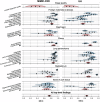Automatic structuring of radiology reports with on-premise open-source large language models
- PMID: 39390261
- PMCID: PMC11913902
- DOI: 10.1007/s00330-024-11074-y
Automatic structuring of radiology reports with on-premise open-source large language models
Abstract
Objectives: Structured reporting enhances comparability, readability, and content detail. Large language models (LLMs) could convert free text into structured data without disrupting radiologists' reporting workflow. This study evaluated an on-premise, privacy-preserving LLM for automatically structuring free-text radiology reports.
Materials and methods: We developed an approach to controlling the LLM output, ensuring the validity and completeness of structured reports produced by a locally hosted Llama-2-70B-chat model. A dataset with de-identified narrative chest radiograph (CXR) reports was compiled retrospectively. It included 202 English reports from a publicly available MIMIC-CXR dataset and 197 German reports from our university hospital. Senior radiologist prepared a detailed, fully structured reporting template with 48 question-answer pairs. All reports were independently structured by the LLM and two human readers. Bayesian inference (Markov chain Monte Carlo sampling) was used to estimate the distributions of Matthews correlation coefficient (MCC), with [-0.05, 0.05] as the region of practical equivalence (ROPE).
Results: The LLM generated valid structured reports in all cases, achieving an average MCC of 0.75 (94% HDI: 0.70-0.80) and F1 score of 0.70 (0.70-0.80) for English, and 0.66 (0.62-0.70) and 0.68 (0.64-0.72) for German reports, respectively. The MCC differences between LLM and humans were within ROPE for both languages: 0.01 (-0.05 to 0.07), 0.01 (-0.05 to 0.07) for English, and -0.01 (-0.07 to 0.05), 0.00 (-0.06 to 0.06) for German, indicating approximately comparable performance.
Conclusion: Locally hosted, open-source LLMs can automatically structure free-text radiology reports with approximately human accuracy. However, the understanding of semantics varied across languages and imaging findings.
Key points: Question Why has structured reporting not been widely adopted in radiology despite clear benefits and how can we improve this? Findings A locally hosted large language model successfully structured narrative reports, showing variation between languages and findings. Critical relevance Structured reporting provides many benefits, but its integration into the clinical routine is limited. Automating the extraction of structured information from radiology reports enables the capture of structured data while allowing the radiologist to maintain their reporting workflow.
Keywords: Chest radiography; Large language models; Structured reporting.
© 2024. The Author(s).
Conflict of interest statement
Compliance with ethical standards. Guarantor: The scientific guarantor of this publication is P.W. and F.C.L. Conflict of interest: The authors of this manuscript declare relationships with the following companies: P.W. is a consultant at Smart Reporting GmbH. D.T. holds shares in StratifAI GmbH and has received honoraria for lectures by Bayer AG. B.B. is Founder and CEO of LernRad GmbH and has received speaker honoraria from Bayer Vital GmbH. T.A.D. is a Scientific Editorial Board member of European Radiology, and D.P.D.S. is a Deputy Editor of European Radiology; they have not taken part in this paper’s review and decision process. Statistics and biometry: One of the authors (F.C.L.) has significant statistical expertise. Informed consent: Written informed consent was waived by the Institutional Review Board. Ethical approval: Institutional Review Board approval was obtained (nr: 20221004-02). Study subjects or cohorts overlap: The MIMIC chest X-ray (MIMIC-CXR) cohort was published in 2019 ( https://doi.org/10.1038/s41597-019-0322-0 ). It is publicly available. Methodology: Retrospective Experimental Performed at one institution
Figures




References
-
- Weiss DL, Kim W, Branstetter BF, Prevedello LM (2014) Radiology reporting: a closed-loop cycle from order entry to results communication. J Am Coll Radiol 11:1226–1237. 10.1016/j.jacr.2014.09.009 - PubMed
MeSH terms
Grants and funding
LinkOut - more resources
Full Text Sources

